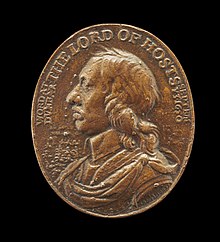| Revision as of 09:47, 3 January 2025 editTheBestEditorInEngland (talk | contribs)Extended confirmed users2,801 edits Sat in a sandbox for far too long, creating an article with the small amount I have already done although there is lots of room for expansion an the topic is notable for an article.Tag: Disambiguation links added | Revision as of 09:53, 3 January 2025 edit undoTheBestEditorInEngland (talk | contribs)Extended confirmed users2,801 editsNo edit summaryNext edit → | ||
| Line 32: | Line 32: | ||
| }} | }} | ||
| The '''Dunbar Medal''' |
The '''Dunbar Medal''' is a ] of the ] and was sanctioned by Parliament in 1650 to be awarded to officers and other ranks of the ] who participated in the ] on 3 September 1650. Two versions were produced; one in gold for officers, and one is silver for other ranks. The Dunbar Medal is thought by historians and ]s to be the first ever military medal to be eligible to every man present in a campaign or engagement, irrespective of rank. It was worn by a cord or chain around the neck.<ref name=Foot01/> | ||
| ] | ] | ||
| Line 43: | Line 43: | ||
| *{{Cite web |url=http://www.britnumsoc.org/publications/Digital%20BNJ/pdfs/1981_BNJ_51_8.pdf |title=THE CROMWELL DUNBAR MEDALS BY SIMON |first=Marvin |last=Lessen |date=1981 |website=British Numismatic Society |accessdate=6 February 2021 }} | *{{Cite web |url=http://www.britnumsoc.org/publications/Digital%20BNJ/pdfs/1981_BNJ_51_8.pdf |title=THE CROMWELL DUNBAR MEDALS BY SIMON |first=Marvin |last=Lessen |date=1981 |website=British Numismatic Society |accessdate=6 February 2021 }} | ||
| {{Refend}} | {{Refend}} | ||
| {{British campaign medals}} | |||
| {{DEFAULTSORT:Dunbar Medal}} | |||
| ] | |||
| ] | |||
| ] | |||
| ] | |||
Revision as of 09:53, 3 January 2025
Campaign medal awarded for participation in the 1650 Battle of DunbarAward
| Dunbar Medal | |
|---|---|
 The obverse of a silver Dunbar Medal The obverse of a silver Dunbar Medal | |
| Type | Campaign Medal |
| Awarded for | Campaign service |
| Presented by | Commonwealth of England |
| Eligibility | All officers and other ranks of the New Model Army who participated in the Battle of Dunbar on 3rd September 1650 |
| Campaign(s) | Battle of Dunbar (3 September 1650) |
| Clasps | None |
| Established | 1650 |
| First awarded | 1651 |
The Dunbar Medal is a campaign medal of the Commonwealth of England and was sanctioned by Parliament in 1650 to be awarded to officers and other ranks of the New Model Army who participated in the Battle of Dunbar on 3 September 1650. Two versions were produced; one in gold for officers, and one is silver for other ranks. The Dunbar Medal is thought by historians and numismatists to be the first ever military medal to be eligible to every man present in a campaign or engagement, irrespective of rank. It was worn by a cord or chain around the neck.

Citations
References
- Lessen, Marvin (1981). "THE CROMWELL DUNBAR MEDALS BY SIMON" (PDF). British Numismatic Society. Retrieved 6 February 2021.